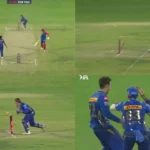Inside an arena in Tampere, Finland, in mid-December, the PWHL’s top future draft prospects faced off in a tournament final.
In the women’s Euro Hockey Tour (or Six Nations Tournament), the Canadians faced an American roster packed with senior national team talent, including Lacey Eden, Abbey Murphy, Caroline Harvey and Laila Edwards.
A Canadian team with less international experience was stuck in the game until the final minutes, when the Americans took the lead on a goal from Murphy for an eventual 5-3 victory. Canadian goalkeeper Ève Gascon made 33 saves in the loss, turning in a performance her coach described as “phenomenal.”
“It’s not necessarily the results against the United States that we were hoping for, but we’re very proud of our team’s performances throughout the tournament,” Canadian national development team head coach Alison Domenico said in an interview with CBC Sports. .
“Just that last game to come back from, being down a couple, it could have been easy to come back from.”

Although several players from both sides of that final are likely to be high PWHL draft picks in the coming years, the tournament was not broadcast in Canada or Hockey Canada.
While many Canadians will see top NHL prospects at the world junior hockey championship for men under 20, which begins Dec. 26, there is no world championship for women of the same age.
There is a world championship for women under 18, which will take place in Finland in January and will be broadcast nationally on TSN.
But there are few international opportunities between that tournament and the senior team, creating a development gap as women aim to reach the sport’s highest level.
For fans, it also means fewer opportunities to watch and get excited about future PWHL stars. Most will move on from the under-18 tournament to play in the NCAA, but those games aren’t always easy to find in Canada either.
SEE | Alex Carpenter and Sarah Fillier of the New York Sirens test their chemistry off the ice:
Host Anastasia Bucsis tests her new teammates and linemates to determine if their on-ice chemistry translates.
Earlier this year, the IIHF said a women’s junior world championship is on the horizon, but it’s not likely to happen for several years, the Canadian Press reported.
Increase the player pool
In Europe, the problem is that there are not enough players to fill the under-18 teams, a senior team and another age group in between, according to Mike Helber, director of hockey operations for the Swedish ice hockey team. Association.
“What will end up happening is that our best players will play in at least two of the tournaments, maybe even all three,” Helber said in an interview with CBC Sports.
SEE | Hockey North gives each PWHL team a holiday gift:
Host Anastasia Bucsis joins PWHL expert Karissa Donkin to break down one thing on every team’s Christmas wish list heading into the new year.
On the other hand, it is difficult for players to develop without opportunities to play against top players. Helber’s goal is to increase the number of Swedish players between the ages of 19 and 24, and to get more of those players to come to North America to study at university.
Those players grow up playing against top Canadian and American prospects, and they bring what they learn to Sweden when they return to their national team, Helber said.
“We need to bring more players to North America to see how good they really are,” said Helber, an American who played college hockey at the University of Michigan. “Sometimes they are surprised.”
Once the player pool grows, Helber would be open to seeing a world championship for college-aged players.
In the meantime, he still wants Swedish players to have the opportunity to compete against other countries.
He liked the format of the Six Nations tournament and is also looking for opportunities for the Swedish team to compete against American university teams.
“They need to see the level at which American athletes play,” he said. “The best way to do it is to find ways to play against them.”
Focus on future PWHL talent
Countries didn’t just send players of a certain age to the Six Nations tournament. The PWHL took a break during the tournament, but most of the PWHL’s European players opted to stay with their clubs, with a few exceptions, such as Boston Fleet goalie Emma Söderberg (Sweden).
Like the United States, Canada sent its development team, which has only a handful of opportunities to compete each year. The team also played a three-game series against the Americans last summer, in which the United States won two games to one.
Some players on the development team could be an important part of Canada’s senior team at the 2030 Olympics and beyond, including defender Nicole Gosling, who won a world championship with the senior team in April, and Caitlin Kraemer. Canada’s all-time leading scorer at the U18 Women’s World Championship.

Without an intermediate world championship for those players, it’s important to find ways to continue giving them international experience, Domenico said.
“Either way we can get them to play in other countries and even get them used to traveling abroad and adopt the jet lag plan,” he said. “Going through all those experiences is really important when you get to the next level.”
For the PWHL, there could be some benefits to having the best up-and-coming college-age players compete against each other.
It could help teams scout prospects. It could also help introduce a player like Kraemer to more fans before she is drafted into the PWHL, just as a world junior tournament has done for top young players like Macklin Celebrini or Connor Bedard.
“The PWHL supports the development of women’s hockey at all levels, including events that would provide greater opportunities for player development and continue to grow the game globally,” said the PWHL’s senior vice president of hockey operations. league, Jayna Hefford. CBC Sports.







